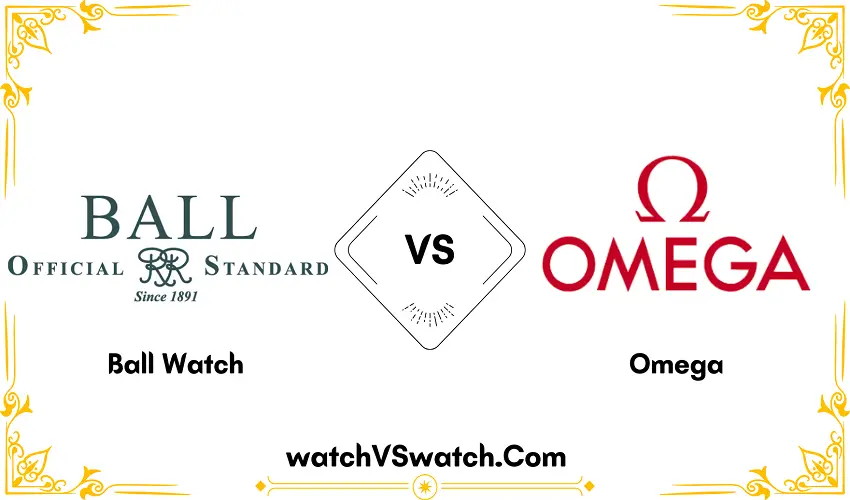Ball Watch and Omega are two renowned Swiss watch brands known for precision and quality craftsmanship. Ball Watch is recognized for its robust and reliable timepieces designed for durability and accuracy, while Omega is celebrated for its luxury and innovation in watchmaking.
Each brand appeals to different audiences with unique styles and features, making them popular choices in the watch industry. We will compare Ball Watch and Omega in terms of their history, design, technology, and reputation to help you make an informed decision when choosing your next timepiece.
Let’s delve into the world of luxury watches and explore what sets these two brands apart.
History Of Ball Watches
In the world of horology, Ball Watch and Omega are renowned brands known for their precision timepieces. In this blog post, we will delve into the history of Ball Watches, exploring their origins, innovation, and technology.
Origins Of Ball Watches
The story of Ball Watches dates back to the late 19th century when the American railroad industry faced a significant challenge with safely coordinating train schedules. To address this, Webster Clay Ball, a jeweler and watchmaker, was appointed as the Chief Time Inspector for the lines associated with the Lake Shore and Michigan Southern Railway Company.
This marked the inception of Ball Watches as a pioneer in creating reliable and accurate timepieces crucial for the safety of the railway network.
Innovation And Technology
Ball Watches have a rich history closely intertwined with innovation and breakthrough technology. From the pioneering use of Swiss movements to implementing robust materials in their timepieces, Ball Watches continuously pushed the boundaries of watchmaking.
The brand’s commitment to accuracy and durability has led to the development of advanced anti-shock and anti-magnetic technologies, setting a high standard for precision in the industry.
History Of Omega Watches
The History of Omega Watches: Omega is a renowned Swiss watchmaker with a rich history dating back to 1848.
Origins Of Omega Watches
In 1848, Louis Brandt founded a small workshop in La Chaux-de-Fonds, Switzerland, laying the foundation for Omega Watches.
Innovation And Technology
Omega has been a pioneer in watchmaking, introducing innovations like the first minute-repeating wristwatch.
Features And Technologies
When comparing Ball Watch and Omega, understanding the features and technologies of each brand is crucial in making an informed decision. Let’s delve into the distinct characteristics of Ball Watch and Omega timepieces.
Ball Watch Features
- Engineered for Precision: Ball Watches are renowned for their accuracy and reliability.
- Glowing Technology: Utilizes self-powered micro gas lights for exceptional nighttime visibility.
- Robust Construction: Crafted with high-quality materials to withstand tough conditions.
- Shock Resistance: Designed to endure shocks and vibrations for enhanced durability.
Omega Watch Features
- Master Chronometer Certification: Omega watches undergo rigorous testing for ultimate precision and performance.
- Co-Axial Escapement: Offers superior mechanical efficiency and reduced friction for enhanced longevity.
- Luxurious Design: Omega timepieces exude elegance and sophistication with refined aesthetics.
- Advanced Materials: Incorporates innovative materials to ensure durability and longevity.
Design And Aesthetics
When it comes to choosing a luxury watch, the design and aesthetics play a pivotal role in defining its allure. Both Ball Watch and Omega are renowned for their exceptional craftsmanship and attention to detail.
Let’s delve into the Design and Aesthetics of these two esteemed timepiece brands to understand their distinct styles and appeal.
Ball Watch Design
The design philosophy of Ball watches embodies a blend of vintage charm and contemporary functionality. The brand takes inspiration from its rich heritage in railroad timekeeping, reflecting in their rugged and robust designs.
The meticulous attention to detail in every Ball watch exudes a sense of sophistication and reliability. Their robust yet refined designs cater to those with an appreciation for traditional craftsmanship and durability.
Omega Watch Design
Omega watches boast a timeless and elegant design aesthetic that has captured the hearts of watch enthusiasts for decades. The brand’s commitment to innovation is evident in the sleek and sophisticated designs that seamlessly combine form and function.
From the iconic Speedmaster to the classic Seamaster models, Omega watches are celebrated for their versatility and enduring appeal.
Price Range And Value
When it comes to purchasing a luxury watch, the price range and value are crucial factors to consider. It’s important to find a timepiece that not only fits your budget but also offers great value for the money.
In this article, we will compare the price range and value between Ball Watch and Omega, two renowned watch brands in the market.
Ball Watch Pricing
Ball Watch offers a range of high-quality timepieces that cater to different budgets. The price of their watches varies depending on the model, features, and materials used.
Generally, the entry-level Ball watches start at around $1,000 and can go up to $5,000. However, their more exclusive and limited-edition models can reach prices of over $10,000.
If you’re looking for a well-crafted, Swiss-made watch without breaking the bank, Ball Watch provides excellent options in the mid-range price segment. These watches offer superb craftsmanship, precision, and durability, making them a solid investment.
Omega Watch Pricing
Omega is a prestigious watch brand known for its exceptional quality and craftsmanship. Their watches are available in a wide range of price points, from affordable to extravagant. The price of Omega watches largely depends on the collection, design, complications, and materials used.
For those looking for an entry-level Omega watch, prices typically start around $2,000 and can go up to $8,000. However, Omega’s iconic and highly sought-after models, such as the Seamaster or Speedmaster, can range from $5,000 to well over $20,000, especially if they offer special features or limited editions.
Comparison Of Value
When comparing the value of Ball Watch and Omega, both brands excel in their respective price ranges. Ball Watch offers exceptional value for money in the mid-range segment, providing Swiss-made watches that are built to last.
Their attention to detail, accuracy, and innovation make them an attractive option for watch enthusiasts who want quality without the exorbitant price tag.
On the other hand, Omega’s reputation as a luxury watch brand speaks for itself. While their watches come at higher price points, they offer unparalleled craftsmanship, iconic designs, and rich heritage.
Investing in an Omega watch ensures not only a beautiful timepiece but also a piece of horological history that holds its value well over time.
| Ball Watch | Omega Watch |
|---|---|
| Mid-range pricing | Wide price range |
| Swiss-made quality | Prestigious reputation |
| Attention to accuracy and innovation | Iconic designs and heritage |
In conclusion, when comparing Ball Watch and Omega in terms of price range and value, both brands offer excellent choices.
Ball Watch caters to those seeking quality watches within a more affordable price range, while Omega appeals to individuals willing to pay a premium for luxury and craftsmanship.
Ultimately, the decision comes down to personal preference, budget, and what aspects of a watch matter most to you.
Frequently Asked Questions Of Ball Watch Vs Omega
Is Ball Watch A Luxury Brand?
Yes, Ball watch is considered a luxury brand known for its high-quality timepieces. The brand has a reputation for precision, craftsmanship, and durability.
Is Ball Watch Worth Buying?
Yes, Ball Watch is worth buying for its high-quality craftsmanship, precision engineering, and exceptional durability.
Is Omega Higher Quality Than Rolex?
Omega and Rolex offer high-quality watches, each with its own strengths. Which brand is better depends on personal preference.
Is Ball Watch Made In China?
No, Ball watches are not made in China. They are primarily manufactured in Switzerland and are known for their high-quality craftsmanship.
Conclusion
Ultimately, when choosing between Ball Watch and Omega, it comes down to personal preferences, budget, and specific requirements. Both brands offer a rich history, exceptional craftsmanship, and reliable timepieces.
Consider your individual style and needs to make an informed decision. Whichever you choose, you’ll have a watch that exudes quality and timeless elegance.

